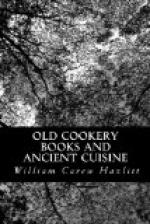The Anglo-Norman used butter where his Italian contemporary used oil. But it is doubtful whether before the Conquest our ancestors were commonly acquainted with butter.
The early cook understood the art of glazing with yolk of egg, and termed it endoring, and not less well that of presenting dishes under names calculated to mislead the intended partaker, as where we find a receipt given for pome de oringe, which turns out to be a preparation of liver of pork with herbs and condiments, served up in the form of glazed force-meat balls.
Venison was salted in troughs. In the tale of “The King and the Hermit,” the latter exhibits to his unknown visitor his stock of preserved venison from the deer, which he had shot in the forest.
The mushroom, of which so many varieties are at present recognised by botanists, seems, from the testimony of an Italian, Giacomo Castelvetri, who was in London in 1614, and to whom I have already referred, to have been scarcely known here at that time. I cannot say, of course, how far Castelvetri may have prosecuted his inquiries, though he certainly leaves the impression of having been intelligently observant; or whether he includes in this observation the edible toadstools; but even now much unreasonable prejudice exists as to the latter, and very limited use is made of any but two or three familiar sorts of the mushroom itself. It is a pity that this misconception should not be dissipated.
Caviary had been brought into England, probably from Russia, at the commencement of the seventeenth century, perhaps sooner. In 1618, “The Court and Country,” by Breton, seems to represent it as an article of diet which was little known, and not much relished; for a great lady had sent the writer’s father a little barrel of it, and it was no sooner opened than it was fastened down again, to be returned to the donor with a respectful message that her servant had black soap enough already.
In the time of James I. the ancient bill of fare had been shorn of many of its coarser features, so far as fish was concerned; and the author of “The Court and Country” tells a story to shew that porpoise-pie was a dish which not even a dog would eat.
The times had indeed changed, since a King and a Cardinal-archbishop judged this warm-blooded sea-dweller a fit dish for the most select company.
It is not a despicable or very ascetic regimen which Stevenson lays before us under April in his reproduction of Breton’s “Fantasticks,” 1626, under the title of the “Twelve Months,” 1661:—“The wholesome dyet that breeds good sanguine juyce, such as pullets, capons, sucking veal, beef not above three years Old, a draught of morning milk fasting from the cow; grapes, raysons, and figs be good before meat; Rice with Almond Milk, birds of the Field, Peasants and Partridges, and fishes of stony rivers, Hen eggs potcht, and such like.”
Under May he furnishes us with a second and not less appetising menu:—




